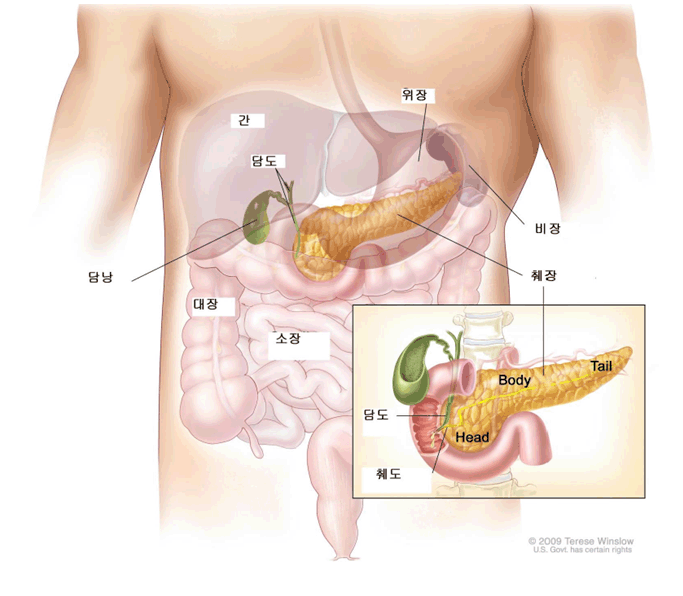When a diagnosis of pancreatic cancer is made, a stage, which comprehensively indicates how far the cancer has progressed, is determined in order to establish an appropriate treatment policy. Pancreatic cancer staging follows the TNM classification method, where T (tumor) represents the size and invasion of the primary tumor, N (node) represents the degree of spread to surrounding lymph nodes, and M (metastasis) represents whether or not it has metastasized to other organs. .
By combining the three elements of the TNM classification, pancreatic cancer stages are divided into stages 1-4. Stage 1 pancreatic cancer is when the cancer is confined to the pancreas and there is no metastasis. Stage 2 is when the cancer has spread to the surrounding organs but does not invade major arterial vessels. If it is impossible, it is classified as stage 3, and if the cancer has spread to distant organs such as the lungs, peritoneum, or liver, it is classified as stage 4.
Pancreatic cancer treatment methods are selected in consideration of the size and location of the cancer, the stage of the cancer, and the patient’s age and health condition. Surgery, chemotherapy, and radiation therapy are sometimes treated as one method, or several therapies are combined. Recently, chemotherapy is first administered before surgery, and then surgery is performed after response evaluation. The only treatment that can be expected to cure pancreatic cancer is surgery, but only about 20% of patients can undergo radical surgery.
As pancreatic cancer is difficult to detect at an early stage, the prognosis on average is poor compared to other cancers. Even after completing treatment such as surgery, it is necessary to continuously monitor whether the cancer has recurred or metastasized. Recurrence after surgery usually occurs between 1 and 2 years. In case of recurrence, the treatment method is determined according to the patient’s condition and the location and extent of recurrence. In general, chemotherapy is performed, and in some cases, radiation therapy is combined.
About 40% of pancreatic cancer patients cannot be surgically resected but have no metastases. Radiation therapy can be performed on them, and the survival period is often prolonged when chemotherapy is administered along with radiation therapy. In addition, radiation may be irradiated during surgery. In this way, it is possible to shoot a large amount of radiation to cancer tissue while minimizing damage to surrounding tissue.
When jaundice occurs due to obstruction of the bile duct by pancreatic cancer, bile can be drained by inserting a stent into the bile duct using an endoscope. This is called endoscopic retrograde cholestasis (ERBD). Because pancreatic cancer causes very severe pain, it is often necessary to use narcotic analgesics. In this case, nerve anesthesia of the celiac ganglion can be attempted by endoscopic ultrasound or percutaneous needle insertion.
As pancreatic cancer is difficult to detect at an early stage, the prognosis on average is poor compared to other cancers. After completing treatment such as surgery, it is necessary to continuously monitor whether the cancer has recurred or metastasized. Recurrence after surgery usually occurs between 1 and 2 years. There are many cases of distant metastasis to the liver or peritoneum, or cancer infiltrating near the surgical site to form a new mass.
Patients who have undergone surgery for pancreatic cancer may develop diabetes because insulin secretion is significantly reduced, so blood sugar must be controlled through insulin treatment. Since the pancreas is an organ that secretes digestive juices, pancreatic cancer patients often find it difficult to eat food due to poor digestion, loss of appetite, and nausea and vomiting caused by side effects of treatment. It is good to eat often.
According to the Central Cancer Registry data released in 2022, the 5-year relative survival rate for pancreatic cancer in 2016-2020 was 15.2% (male 14.2%, female 16.2%). The 5-year relative survival rate of pancreatic cancer was 10.6% from 1993 to 1995 (male and female), 8.7% from 1996 to 2000, 8.4% from 2001 to 2005, 8.6% from 2006 to 2010, 10.9% from 2011 to 2015, and 10.9% from 2016 to 2020. 15.2% per year, etc. The 5-year (2016-2020) relative survival rate by summary stage of pancreatic cancer is 48.0% for localized, 20.4% for regional, 2.4% for distant, and 17.1% for unknown. Summary staging is a classification method that categorizes how far the cancer has spread from its primary site.
There is no established pancreatic cancer prevention rule yet, so to prevent pancreatic cancer, known risk factors should be avoided in daily life. In other words, it is necessary to abstain from smoking, avoid high-fat and high-calorie diets, eat a diet rich in fruits and vegetables, and exercise regularly to maintain an appropriate weight. In addition, diabetic patients are twice as likely to develop pancreatic cancer compared to normal people, so diabetes must be continuously treated. Patients with chronic pancreatitis should also be actively treated.
Cancer patients should have an active and positive mind to overcome the disease by discarding vague fears and trusting the medical staff in charge. This mindset is one of the most important factors in cancer treatment. You should try to adapt well to treatments such as surgery, radiation therapy, and chemotherapy, and you should receive follow-up treatment to prevent recurrence. In daily life, light exercise should be done regularly to maintain an appropriate weight.


